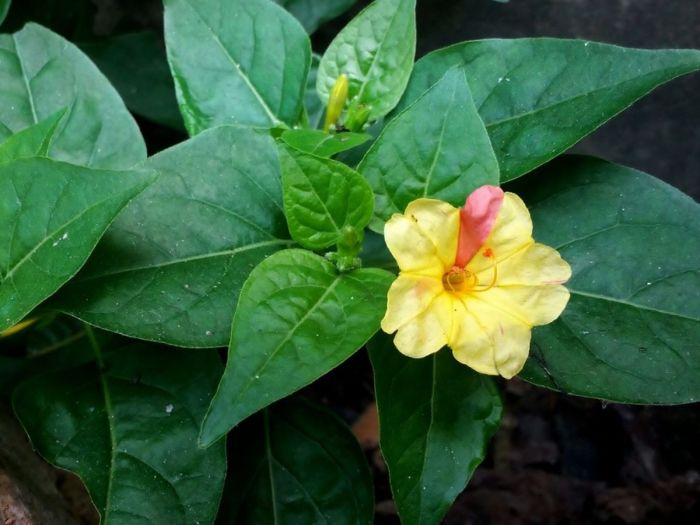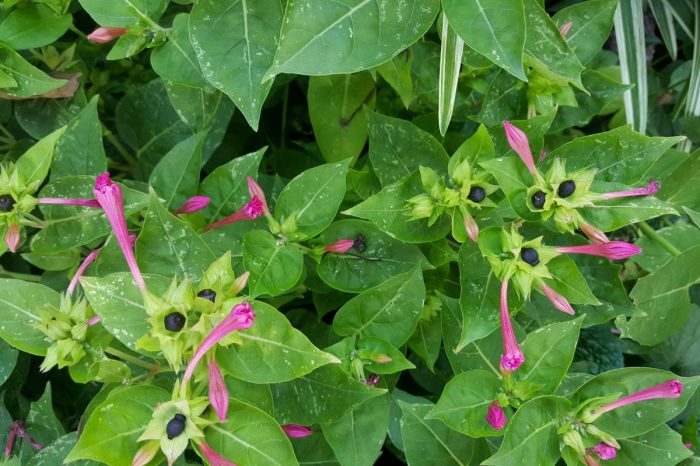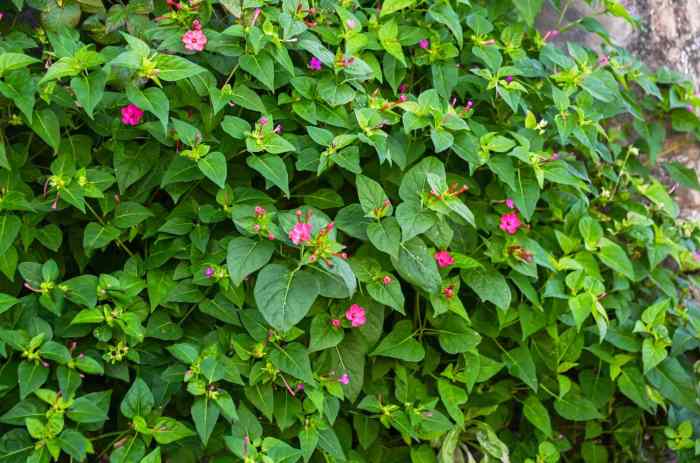Four O’Clock Plant Seed Characteristics
Four o’clock plant seeds – Four o’clock plants (Mirabilis jalapa*) produce seeds that are easily identifiable due to their distinctive features. Understanding these characteristics is crucial for successful propagation and cultivation. The following analysis details the physical attributes of these seeds, comparing them to those of other common flowering plants.
Seed Physical Attributes
Four o’clock plant seeds are generally black or dark brown, exhibiting a hard, smooth texture. They are relatively small, ranging in size depending on the cultivar and growing conditions. The seed coat is quite resilient, providing protection during dormancy and facilitating dispersal. The shape is broadly ovate, somewhat resembling a small, flattened pebble. Variations in color, though less common, can include shades of dark grey or even a mottled appearance.
The seed’s surface is usually smooth, but some minor textural variations can be observed under magnification.
Seed Coat Texture and Color
The seed coat of the four o’clock plant is characterized by its hard, smooth, and somewhat glossy surface. The predominant color is a deep, dark brown or black, although variations exist. These variations can be subtle, such as lighter shading in certain areas, or more pronounced, involving mottled patterns of dark brown and black. The hardness of the seed coat plays a significant role in its ability to withstand environmental conditions and maintain viability over time.
Planting four o’clock plant seeds is relatively easy, requiring minimal preparation. The process involves sowing the seeds directly into well-draining soil. Similar principles apply to other seeds, and learning how to plant different types of seeds can broaden your gardening skills. For instance, understanding the process for larger seeds, such as those found in fruits, is beneficial; you can find a comprehensive guide on how to plant plum seeds.
This knowledge will help you successfully cultivate a wider variety of plants, including those delicate four o’clock seeds.
The smooth surface minimizes friction, potentially aiding in dispersal by wind or water.
Seed Size and Shape Comparison
Four o’clock seeds are relatively small compared to many other common flower seeds. For instance, they are significantly smaller than sunflower seeds or pumpkin seeds. They are also smaller than many bean seeds. Their size is comparable to, though perhaps slightly larger than, poppy seeds or petunia seeds. The shape, as mentioned, is generally ovate, although some minor irregularities might be present.
This ovate shape differs from the more elongated shapes of some seeds, like those of morning glories, or the rounder shapes of many other small flower seeds.
| Seed characteristic | Description | Image Description (detailed) | Comparison to other seeds |
|---|---|---|---|
| Size | Small; approximately 2-3 mm in length | Imagine a small, dark brown or black pebble, slightly flattened and ovate in shape. The surface is smooth and glossy, reflecting light subtly. | Smaller than sunflower or pumpkin seeds; comparable to or slightly larger than poppy or petunia seeds. |
| Shape | Ovate; slightly flattened | The seed is wider at one end and tapers slightly towards the other, resembling a miniature, dark-colored egg. | Differs from the elongated shape of morning glory seeds or the round shape of many other small flower seeds. |
| Texture | Hard, smooth, and glossy | The surface appears smooth to the naked eye, with a slight sheen or gloss. Under magnification, minor textural variations might be visible. | Similar in hardness to other small, hard-coated seeds but with a smoother surface compared to some. |
| Color | Predominantly dark brown or black; variations include dark grey or mottled patterns | The seed is uniformly dark brown or black in most cases, but some seeds might exhibit lighter shading or mottled patterns of dark brown and black. | Similar in color to many other dark-colored seeds, but the uniformity or mottled pattern differentiates it from some. |
Four O’Clock Plant Seed Planting Techniques

Successful cultivation of four o’clock plants hinges on understanding and implementing appropriate planting techniques. Factors such as soil composition, spacing, and planting location significantly influence the plant’s growth, flowering, and overall health. This section details optimal methods for planting four o’clock seeds to ensure a thriving display.
Soil Type and pH for Four O’Clock Plants
Four o’clock plants thrive in well-drained soil that is rich in organic matter. Heavy clay soils should be amended with compost or other organic materials to improve drainage and aeration. Sandy soils, while well-draining, may benefit from the addition of organic matter to retain moisture. The ideal soil pH for four o’clock plants is slightly alkaline, ranging from 6.0 to 7.5.
Testing your soil’s pH using a home soil testing kit is recommended to determine if adjustments are necessary. If the pH is too acidic, adding lime will raise it; if it’s too alkaline, adding sulfur will lower it. Consistent monitoring and adjustments will ensure optimal growing conditions.
Spacing of Four O’Clock Plants
Proper spacing is crucial for preventing overcrowding and promoting healthy growth. Four o’clock plants, depending on the variety, can grow quite large, often reaching heights of 2-4 feet and spreading similarly. Therefore, adequate spacing is essential for air circulation and sunlight penetration. When planting in a garden bed, a spacing of 18-24 inches between plants is generally recommended.
This allows for sufficient room for root development and prevents competition for resources. Closer spacing may lead to stunted growth and increased susceptibility to diseases.
Planting Plan for a Small Garden
Consider a small, sunny garden bed measuring approximately 4 feet by 6 feet. This space can accommodate three four o’clock plants. To maximize sunlight exposure, position the plants evenly spaced across the bed, approximately 2 feet apart. To complement the four o’clocks, consider adding low-growing, drought-tolerant plants such as sedum or dianthus between them. These plants will fill the spaces, creating a visually appealing and harmonious garden.
The garden bed should be situated in a location that receives at least 6 hours of direct sunlight daily. This arrangement ensures each plant receives adequate sunlight while avoiding competition for resources. Regular watering, particularly during dry spells, is vital for maintaining soil moisture.
Planting Four O’Clock Seeds: Containers versus Direct Ground Planting
Planting four o’clock seeds directly into the ground or in containers offers distinct advantages and disadvantages. Direct sowing allows plants to establish deeper root systems, leading to greater drought tolerance. However, germination rates may be lower and the seedlings are more vulnerable to pests and harsh weather conditions. Planting in containers offers greater control over environmental factors, allowing for easier management of watering, temperature, and pest control.
Containers also provide the flexibility to move plants to more suitable locations as needed. Choosing the best method depends on the specific climate, resources, and gardener’s experience. For beginners, container planting often proves less challenging, allowing for a controlled environment to nurture the seedlings before transplanting into the garden.
Four O’Clock Plant Seedling Care

Successful cultivation of four o’clock plants extends beyond seed germination; nurturing healthy seedlings is crucial for robust flowering plants. Seedlings are particularly vulnerable to various environmental and biological factors, requiring careful attention to detail during their early development. This section details common seedling problems, preventative measures, hardening-off techniques, and proper thinning practices.
Common Four O’Clock Seedling Problems
Several issues can hinder the growth of four o’clock seedlings. Damping-off, a fungal disease, is a significant threat, causing the stems to rot and collapse near the soil line. Overwatering can lead to root rot, exhibiting similar symptoms. Conversely, underwatering results in stunted growth and wilting. Nutrient deficiencies manifest as pale or yellow leaves, while pest infestations, such as aphids or spider mites, can damage leaves and stunt growth.
Finally, insufficient light can lead to leggy, weak seedlings.
Preventative Measures for Healthy Seedling Growth, Four o’clock plant seeds
Preventing problems is far more effective than treating them. Using a sterile seed-starting mix reduces the risk of damping-off. Proper watering techniques, ensuring the soil is consistently moist but not soggy, are essential. Providing adequate light, either through direct sunlight or grow lights, promotes healthy growth. Regularly checking seedlings for pests and applying appropriate organic or chemical controls is crucial.
Using a balanced fertilizer at half strength will supply necessary nutrients without burning the delicate seedlings.
Hardening Off Four O’Clock Seedlings
Before transplanting seedlings outdoors, they must be gradually acclimated to the harsher conditions. This process, known as hardening off, reduces transplant shock. Begin by exposing seedlings to outdoor conditions for a short period (1-2 hours) during the coolest part of the day, gradually increasing the duration and intensity of exposure over several days. Protect seedlings from direct sunlight, wind, and extreme temperatures during the hardening-off period.
Once seedlings can tolerate full sun and temperature fluctuations for several hours without wilting, they are ready for transplanting.
Thinning Four O’Clock Seedlings
Overcrowding among seedlings leads to competition for resources, resulting in weaker, smaller plants. Thinning involves selectively removing some seedlings to provide adequate space for the remaining ones to thrive. Thin to ensure each seedling has sufficient space (approximately 2-4 inches apart) for optimal root and shoot development. Remove weaker seedlings, leaving the strongest and most vigorous ones.
This process is best performed when seedlings have developed their first few true leaves. Careful removal, using small scissors or tweezers to avoid disturbing the roots of remaining seedlings, is recommended.
Four O’Clock Plant Seed Storage and Viability

Proper storage significantly impacts the longevity and germination success of four o’clock plant seeds. Understanding the factors affecting seed viability and employing appropriate storage techniques are crucial for successful propagation. Ignoring these aspects can lead to low germination rates or complete seed failure.
Factors Affecting Four O’Clock Seed Longevity
Several environmental factors influence the lifespan and viability of four o’clock seeds. Moisture content is paramount; high humidity promotes fungal growth and seed decay, while excessively dry conditions can lead to desiccation and reduced viability. Temperature fluctuations also play a critical role; extreme temperatures, both high and low, can damage the seed embryo, diminishing germination potential. Finally, the presence of oxygen influences seed longevity; prolonged exposure to oxygen can accelerate oxidation processes, negatively affecting seed viability.
Proper storage aims to minimize these negative influences.
Seed Storage Methods and Effectiveness
Several methods exist for storing four o’clock seeds, each with varying degrees of effectiveness. Air-tight containers, such as glass jars with sealed lids, are commonly used to protect seeds from moisture and oxygen. These containers, when stored in cool, dark, and dry environments, provide adequate protection against environmental degradation. Alternatively, hermetically sealed bags with desiccant packets can further reduce moisture content, enhancing seed longevity.
However, the effectiveness of each method depends on the initial moisture content of the seeds and the consistency of storage conditions. Improperly sealed containers or fluctuating temperatures can negate the benefits of any method.
Expected Germination Rates Based on Storage Duration and Conditions
The following table illustrates the estimated germination rates of four o’clock seeds under different storage conditions. These estimates are based on observations from horticultural practices and assume proper seed preparation before storage. Note that these are estimates and actual results may vary depending on seed quality and specific environmental conditions.
| Storage Duration | Optimal Conditions (Cool, Dry, Dark) | Suboptimal Conditions (Room Temperature, Fluctuating Humidity) |
|---|---|---|
| 1 year | 85-95% | 60-75% |
| 2 years | 70-85% | 30-50% |
| 3 years | 50-70% | 10-30% |
| 4 years | 30-50% | <5% |
Four O’Clock Plant Seed Varieties: Four O’clock Plant Seeds
The genusMirabilis* boasts a surprising diversity in its four o’clock plant species, leading to a range of seed characteristics and resulting plant appearances. While many cultivars exist, distinguishing them solely by seed characteristics is difficult; visual characteristics of the mature plant are more reliable. The following examples illustrate some of the variations available.
Variety Descriptions
The following section details three distinct varieties of four o’clock plants, highlighting their unique features. These characteristics, while not always perfectly consistent across individual plants due to factors like environmental conditions and potential cross-pollination, offer a good overview of what to expect.
| Variety Name | Flower Color | Plant Size | Growth Habit |
|---|---|---|---|
| Mirabilis jalapa ‘Alba’ | Pure white | 2-3 feet tall and wide | Upright, bushy growth; relatively compact. |
| Mirabilis jalapa ‘Raspberry’ | Deep pink to raspberry red | 2-3 feet tall and wide | Similar upright, bushy growth to ‘Alba’, though slightly more sprawling. |
| Mirabilis jalapa ‘Yellow’ (or similar yellow-flowered cultivar) | Various shades of yellow, from pale lemon to deep golden yellow. Some cultivars may exhibit variegated flowers. | 2-4 feet tall and wide; can be more vigorous than the other two examples. | More vigorous and sprawling growth than ‘Alba’ or ‘Raspberry’; may require more staking to maintain shape. |
Seed Characteristic Comparisons
While the seeds of these varieties might appear similar in size and shape (small, dark, and somewhat angular), subtle differences might exist in their germination rates and vigor. For example, seeds from more vigorous varieties, like the yellow-flowered ones, may show faster germination and more robust seedling growth under optimal conditions. However, without rigorous scientific testing, these differences are largely anecdotal.
The color of the seed coat itself is not a reliable indicator of the flower color.
FAQs
Are four o’clock plant seeds poisonous?
Yes, all parts of the four o’clock plant, including the seeds, contain compounds that can be toxic if ingested, especially by pets and children.
How long do four o’clock seeds remain viable?
Under proper storage conditions (cool, dry, dark), four o’clock seeds can retain viability for several years, although germination rates may decline over time.
Can I start four o’clock seeds outdoors?
Yes, direct sowing is possible after the last frost, but starting indoors provides a head start and better control over germination.
What should I do if my four o’clock seedlings are leggy?
Leggy seedlings indicate insufficient light. Increase light exposure, or use grow lights to promote sturdy growth.
